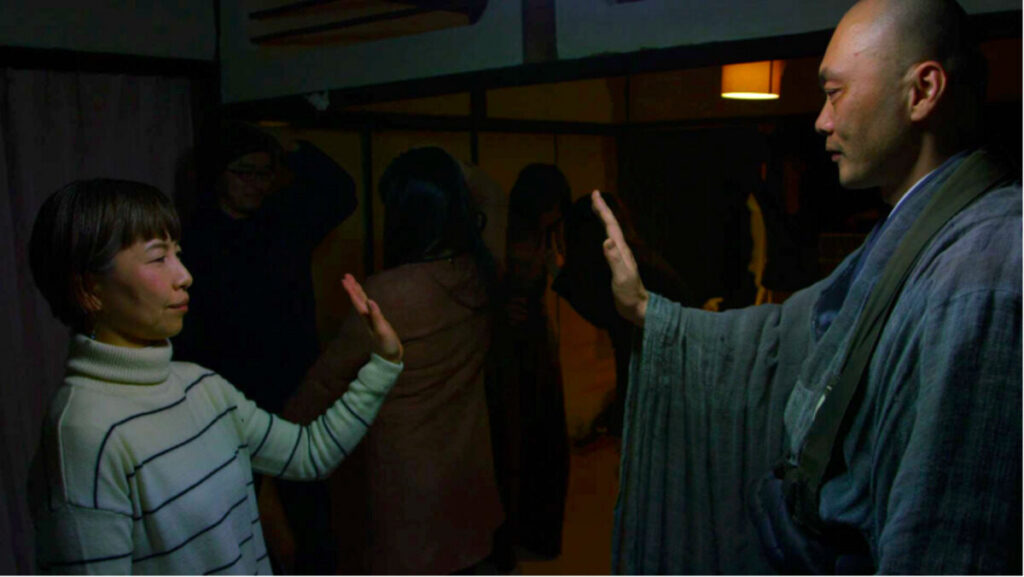ALEIX RUIZ FALQUÉS
One of the apparently most disconcerting phenomena in rich societies is the high rate of suicide. It is a very particular problem because of its taboo component and the impossibility of unravelling the real causes that may lead a person to take his or her own life. Being the decision a personal and non-transferable combination of lucid and confused reasoning. In a society that desperately seeks scientific, effective and definitive medical solutions through the control of tangible matter, the impossibility of predicting and treating spiritual or mental problems becomes a source of constant frustration. At the same time, it is impossible not to take action, and we can say that everyone is doing the best they can with the means at their disposal, like someone trying to navigate through a dense fog.

The documentary The Departure, directed by Lana Wilson, addresses the issue of suicide from the perspective of preventive therapy. Is there a formula for treating people who have suicidal thoughts? Ittetsu Nemoto, the Japanese Zen monk who is the main character in the documentary, devotes himself body and soul to visit and advice potential suicidal people. Some show obvious signs of mental imbalance, such as the man who (understandably) cannot bear to see his children only for an hour a month and feels he has failed as a father and as a person. Other patients show no signs that would distinguish them from what we would call ordinary people. However, the recurring thought of taking their own life has invaded their lives and they are helpless to face the temptation to end it once and for all. This is where the peculiar Zen monk Nemoto comes in, who receives non-stop calls and messages by mail and phone, and is available around the clock to care for people on the brink of the chasm.
In addition to visiting his “patients”, the monk Nemoto organises a regular retreat called “the departure”. This is an exercise of group meditation about death and leaving behind the most cherished things and people. It is a kind of simulation of one’s own death. The monk asks the workshop participants to write down on slips of paper the nine things they could not do without. Then he asks them to remove strips of paper until only one is left: what they would choose if they could only keep one thing. But even this tiny strip of paper has to be discarded in the end. “My mother” reads on the paper of one participant, “my memories” says another, “travelling the world” has been written by another participant. One after another they discard the last remaining piece of paper. “Now you have lost everything. This is death.”

The most remarkable thing about Nemoto’s method is its lack of system, the absence of protocol. He is driven by compassion, strictly speaking. He does not feel the pain and confusion of his patients as something alien. He is emotionally involved and committed to them. Perhaps it is true that the monk does not possess great oratory skills. In his conversations with potential suicidal patients he does not rush to give a fully articulate and rational response to the issues raised. Rather, he listens with his heart, trying to live what the suffering person is experiencing. He does not use theory or protocol first. In this sense, Nemoto is a Zen therapist and not a psychiatrist. He does not seek to judge the suicidal person; it seems that he does not even try to prevent the suicide from being committed. Nemoto himself sometimes suggests that he too often feels the urge to end it all. With this kind of quiet, casual conversation, he acts as a mirror, so that the other person can better understand the reason for his frustration and his desire to disappear.
One of the recurring topics in Master Nemoto’s teaching, which is otherwise a vague and foggy teaching, is the impossibility of giving meaning to what has no meaning in itself. When one of the girls in one of the workshops on death tells him that sometimes she would like to understand the meaning of life, the monk replies that perhaps there are certain things that do not necessarily need to have meaning: “Does a river need to have meaning?” There is a subtle difference between this remark and nihilism which would directly assert that things have no meaning. The monk neither affirms nor denies that life is meaningful or meaningless. He simply questions the approach: Does it make sense to ask about meaning? Does everything need to have a meaning? Is it necessary to be so? It seems to me that here lies the strength of Nemoto’s discourse, for it subtly points to what might be at the root of the suicidal drive: compelling life to offer something it cannot offer, and thus forcing a conflict with no possible solution. What Nemoto proposes is not a solution, but a change of approach, giving the possibility of another kind of approach to life.
Nemoto himself is at a crossroads that also reflects the dilemmas of his patients. His health is fragile due to heart problems. The stress of his job and constant concern for depressed people are taking their toll on his health and endangering his life. But at one point he states that perhaps a good life does not have to be long. A short life, but one devoted to helping others, is ultimately a good life. “Perhaps some people see it as a form of suicide,” he ponders at one point. The only thing that worries Nemoto is that his wife and young son will suffer because of him, and so it seems that in the end he decides to change his lifestyle.
In fact one of the most striking elements of this monk is that he goes to discos, he dances, gets drunk and has a family. He became a monk because he saw a newspaper advertisement for a monk to take charge of a Zen monastery. The fact that he applied for the job, however, is no coincidence, as Nemoto was going through a period of change after a very serious accident. He had abandoned his former bohemian and hedonistic life, in which he no longer found any meaning. It seems that in this case “clothes did make the monk”, and although at no point in the film is Buddhist doctrine alluded to, the way in which Nemoto embodies the virtues of compassion and generosity is really touching.

The film has a remarkable aesthetic beauty, at times a bit stark and austere, and a slow pace that leaves room for reflection on the conversations. An interesting and attractive aspect of this documentary is that it does without the format of a direct interview with the protagonist. This is probably due to the fact that the protagonist himself is, in a way, constantly interviewing other people. One does not know whether this is a work of fiction or a documentary. The structure of the story also avoids convention and it is conceived in a circular way, with an anticlimactic ending, in which we seem to be back to the beginning, although with a contradictory feeling of not knowing whether things have changed or stayed the same. A sense of timelessness that somehow symbolises this pause for reflection that Nemoto tries to offer his companions.
This is the second film of Lana Wilson, who had already co-directed with Marta Shane After Tiller (2013), a documentary about doctors who perform abortion in the United States. More recently, she directed the documentary Miss Americana (2020), about Taylor Swift. Her works denote an interest in marginal and controversial points of view, and have a clear component of social criticism. In the case of The Departure, she manages to dig into the drama of human suffering, of suicide in general (not only in Japan), and she succeeds in portraying the activity of a therapist monk in a faithful and respectful way, with a simple art full of subtlety, with an elegance and absence of pedantry worthy of the best Zen art.
————————————
Aleix Ruiz Falqués (Barcelona, 1982) holds a BA in Classical Philology from the University of Barcelona (Spain), an MA in Sanskrit from the University of Pune (India) and a PhD in South Asian Studies (specialising in Pali) from the University of Cambridge (UK). His field of research is Buddhist literature in Pali, specifically the Burmese tradition. He is currently teaching Pali language and literature at the Shan State Buddhist University, Taunggyi (Myanmar), and also teaching Pali at the Institute of Hispanic Buddhist Studies (www.iebh.org). Together with Abraham Vélez de Cea and Ricardo Guerrero, he translated Bhikkhu Bodhi’s book En palabras del Buddha (In Buddha’s words) (Kairós, 2019) and will soon publish the book Los últimos días del Buddha: El Mahāparinibbānasutta pali con el comentario de Buddhaghosa (The Last Days of the Buddha: The Mahāparinibbānasutta pali with Buddhaghosa’s commentary) (Trotta, 2022).
*This article is part of the special edition: “Buddhism and cinema” of Buddhistdoor en Español.



